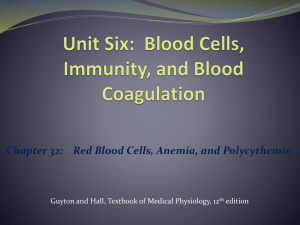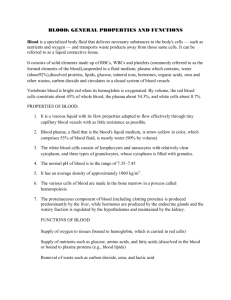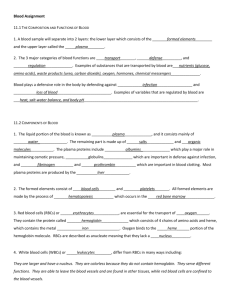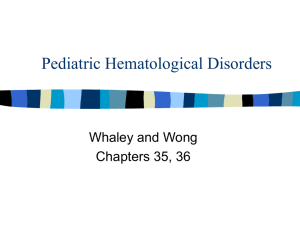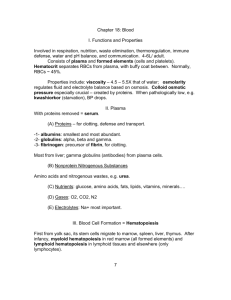biochem ch 44B [9-2
advertisement
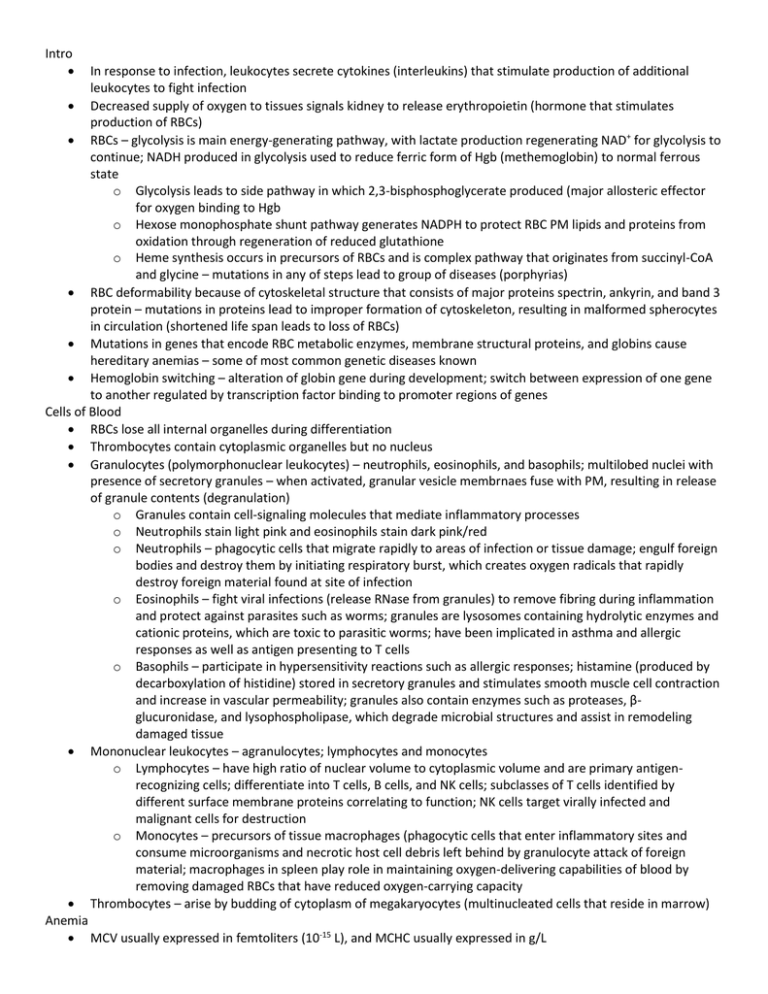
Intro In response to infection, leukocytes secrete cytokines (interleukins) that stimulate production of additional leukocytes to fight infection Decreased supply of oxygen to tissues signals kidney to release erythropoietin (hormone that stimulates production of RBCs) RBCs – glycolysis is main energy-generating pathway, with lactate production regenerating NAD+ for glycolysis to continue; NADH produced in glycolysis used to reduce ferric form of Hgb (methemoglobin) to normal ferrous state o Glycolysis leads to side pathway in which 2,3-bisphosphoglycerate produced (major allosteric effector for oxygen binding to Hgb o Hexose monophosphate shunt pathway generates NADPH to protect RBC PM lipids and proteins from oxidation through regeneration of reduced glutathione o Heme synthesis occurs in precursors of RBCs and is complex pathway that originates from succinyl-CoA and glycine – mutations in any of steps lead to group of diseases (porphyrias) RBC deformability because of cytoskeletal structure that consists of major proteins spectrin, ankyrin, and band 3 protein – mutations in proteins lead to improper formation of cytoskeleton, resulting in malformed spherocytes in circulation (shortened life span leads to loss of RBCs) Mutations in genes that encode RBC metabolic enzymes, membrane structural proteins, and globins cause hereditary anemias – some of most common genetic diseases known Hemoglobin switching – alteration of globin gene during development; switch between expression of one gene to another regulated by transcription factor binding to promoter regions of genes Cells of Blood RBCs lose all internal organelles during differentiation Thrombocytes contain cytoplasmic organelles but no nucleus Granulocytes (polymorphonuclear leukocytes) – neutrophils, eosinophils, and basophils; multilobed nuclei with presence of secretory granules – when activated, granular vesicle membrnaes fuse with PM, resulting in release of granule contents (degranulation) o Granules contain cell-signaling molecules that mediate inflammatory processes o Neutrophils stain light pink and eosinophils stain dark pink/red o Neutrophils – phagocytic cells that migrate rapidly to areas of infection or tissue damage; engulf foreign bodies and destroy them by initiating respiratory burst, which creates oxygen radicals that rapidly destroy foreign material found at site of infection o Eosinophils – fight viral infections (release RNase from granules) to remove fibring during inflammation and protect against parasites such as worms; granules are lysosomes containing hydrolytic enzymes and cationic proteins, which are toxic to parasitic worms; have been implicated in asthma and allergic responses as well as antigen presenting to T cells o Basophils – participate in hypersensitivity reactions such as allergic responses; histamine (produced by decarboxylation of histidine) stored in secretory granules and stimulates smooth muscle cell contraction and increase in vascular permeability; granules also contain enzymes such as proteases, βglucuronidase, and lysophospholipase, which degrade microbial structures and assist in remodeling damaged tissue Mononuclear leukocytes – agranulocytes; lymphocytes and monocytes o Lymphocytes – have high ratio of nuclear volume to cytoplasmic volume and are primary antigenrecognizing cells; differentiate into T cells, B cells, and NK cells; subclasses of T cells identified by different surface membrane proteins correlating to function; NK cells target virally infected and malignant cells for destruction o Monocytes – precursors of tissue macrophages (phagocytic cells that enter inflammatory sites and consume microorganisms and necrotic host cell debris left behind by granulocyte attack of foreign material; macrophages in spleen play role in maintaining oxygen-delivering capabilities of blood by removing damaged RBCs that have reduced oxygen-carrying capacity Thrombocytes – arise by budding of cytoplasm of megakaryocytes (multinucleated cells that reside in marrow) Anemia MCV usually expressed in femtoliters (10-15 L), and MCHC usually expressed in g/L CBC performed by sending cells through automated analyzer based on flow cytometry (one cell at a time), and laser shines light at cell and machine records predictable light scattering Mature Erythrocyte Metabolism Metabolic enzymes limited to those found in cytoplasm; cytosol contains hemoglobin and enzymes necessary for prevention and repair of damage done by reactive oxygen species and generation of energy RBCs only generate ATP by glycolysis – ATP used for ion transport across PM (Na+, K+, and Ca2+), phosphorylation of membrane proteins, and priming reactions of glycolysis o Glycolysis uses Rapoport-Luebering shunt to generate 2,3-bisphosphoglycerate (2,3-BPG) – RBCs have much more than other cells (that require it for phosphoglycerate mutase reaction of glycolysis) o As 2,3-BPG regenerated during each reaction cycle, it is required in catalytic amounts in non-RBCs o 2,3-BPG is modulator of oxygen binding to Hgb that stabilizes deoxy form of Hgb, thereby facilitating release of O2 to tissues To bind oxygen, iron of Hgb must be in ferrous state (2+) Some of NADH produced by glycolysis used to regenerate Hgb from methemoglobin by NADH-cytochrome b5 methemoglobin reductase system; cytochrome b5 reduces Fe3+ of methemoglobin, and oxidized cytochrome b5 then reduced by flavin-containing enzyme (cytochrome b5 reductase) using NADH as reducing agent Inherited deficiency in pyruvate kinase leads to hemolytic anemia – because amount of ATP formed from glycolysis decreased by 50%, RBC ion transporters cannot function effectively o RBCs tend to gain Ca2+ and lose K+ and H2O; H2O loss increases intracellular hemoglobin concentration, which causes increased internal viscosity of cell to point that cell becomes rigid and therefore more susceptible to damage by shear forces in circulation; once damaged, RBCs removed from circulation, leading to anemia o Effects of anemia moderated by 2-3x elevation in 2,3-BPG concentration that results from blockaged of conversion of phosphoenolpyruvate to pyruvate o Because 2,3-BPG binding to Hgb decreases affinity of Hgb for O2, RBCs remain in circulation highly efficient in releasing bound oxygen to tissues 5-10% of glucose metabolized by RBCs used to generate NADPH by hexose monophosphate shunt o NADPH used to maintain glutathione in reduced state; glutathione cycle is RBC’s chief defense against damage to proteins and lipids by reactive oxygen species o Enzyme that catalyzes first step of hexose monophosphate shunt is glucose-6-phosphate dehydrogenase (G6PD); lifetime of RBC correlates with G6PD activity – RBC cannot synthesize new G6PD, so as G6PD activity decreases, oxidative damage accumulates, leading to lysis of erythrocyte Congenital methemoglobinemia – presence of excess methemoglobin; found in people with enzymatic deficiency in cytochrome b5 reductase or in people who inherited hemoglobin M (single AA substitution in heme-binding pocket stabilizes ferric oxygen) o Individuals appear cyanotic but have few clinical problems o Can be acquired by ingestion of nitrites, quinones, aniline, and sulfonamides – treated by administration of reducing agents, such as ascorbic acid or methylene blue G6PD deficiency – most common enzyme deficiency because those with trait resistant to malaria; RBCs have shorter life span and more likely to lyse under conditions of oxidative stress; gene for G6PD on X chromosome o All known G6PD variant genes contain small in-frame deletions or missense mutations, so corresponding proteins have decreased stability or lowered activity, leading to reduced lifespan for RBC o No mutations found that result in complete absence of G6PD because this would result in embryonic lethality Erythrocyte Precursor Cells and Heme Synthesis Heme – consists of porphyrin ring coordinated with atom of iron; 4 pyrrole rings joined by methenyl bridges (=CH-) to form porphyrin ring; 8 side chains serve as substituents on porphyrin ring (2 on each pyrrole) and may be acetyl (A), propionyl (P), methyl (M), or vinyl (V) groups (in normal heme, it is MVMVMPPM clockwise, characteristic of porphyrins of type III series, the most abundant type in nature) o Most common porphyrin in body; complexed with proteins to form hemoglobin, myoglobin, and cytochromes Heme synthesized from glycine and succinyl-CoA, which condense in initial reaction to form δ-aminolevulinic acid (δ-ALA) – enzyme that catylzes reaction (δ-ALA synthase) requires participation of pyridoxal phosphate (reaction is AA decarboxylation reaction; glycine is decarboxylated) o Next reaction catalyzed by δ-ALA dehydratase (2 molecules of δ-ALA condense to form porphobilinogen); 4 of these pyrrole rings condense to form linear chain and then series of porphyrinogens; side chains initially contain A and P groups (A groups decarboxylated and oxidized to V groups, forming protoporphyrin IX o Final step of pathway – Fe2+ incorporated into protoporphyrin IX in reaction catalyzed by ferrochelatase (heme synthase) o δ-ALA dehydratase contains zinc; it and ferrochelatase inactivated by lead; in lead poisoning, δ-ALA and protoporphyrin IX accumulate and production of heme is decreased, leading to anemia and decrease in energy production because of lack of cytochromes for electron-transport chain Heme is red and responsible for color of RBCs and muscles that contain large number of mitochondria In B6 deficiency, rate of heme production slow because first reaction in heme synthesis requires pyroxidal phosphate; less heme then synthesized, causing RBCs to be small and pale; iron stores elevated Porphyrias – group of rare inherited disorders resulting from deficiencies of enzymes in pathway for heme biosynthesis; intermediates of pathway accumulate and may have toxi effects on nervous system that cause neuropsychiatric symptoms; when porphyrinogens accumulate, they may be converted by light to porphyrins, which react with molecular oxygen to form oxygen radicals which may cause severe damage to skin; individuals with excessive production of porphyrins photosensitive; scarring and increased growth of facial hair seen in some porphyrias (werewolf syndrome) Iron obtained from diet – heme from meat readily absorbed, and nonheme iron from plants not readily absorbed because plants often contain oxalates, phytates, tannins, and other phenolic compounds that chelate or form insoluble precipitates with iron preventing its absorption o Vitamin c increases uptake of nonheme iron from digestive tract o Uptake of iron increased in times of need by other mechanisms o Iron absorbed in Fe2+ (ferrous) state but oxidized to ferric state by ferroxidase called ceruloplasmin (copper-containing enzyme) for transport throughout body Iron carried in blood as Fe3+ bound to apotransferrin (complex of iron and apotransferrin is transferrin); transferrin usually only 1/3 saturated with iron; transferrin with bound iron binds to transferrin receptor on cell surface and complex internalized into cell; internalized membrane develops into endosome with slightly acidic pH; iron in ferrous form transported out of endosome into cytoplasm via divalent metal ion transporter 1 (DMT1); in cytoplasm, iron oxidized and binds to ferritin for long-term storage o Storage of iron occurs in most cells, but especially in cells of liver, spleen, and bone marrow; in those cells, storage protein (apoferritin) forms complex with Fe3+ to become ferritin o Ferritin levels in blood increase as iron stores increase, so amount of ferritin in blood is most sensitive indicator of amount of iron in body’s stores o Iron can be drawn from ferritin stores, transported in blood as transferrin, and taken up via receptormediated endocytosis by cells that require iron like reticulocytes synthesizing Hgb o When excess iron absorbed from diet, it is stored as hemosiderin (form of ferritin complexed with additional iron that cannot be readily mobilized Heme regulates its own synthesis by repressing synthesis of δ-ALA synthase and directly inhibits activity of δ-ALA synthase via an allosteric modifier; heme synthesized when heme levels fall and rate of synthesis decreases as heme levels rise o Heme regulates synthesis of Hgb by stimulating synthesis of globin; heme maintains ribosomal initiation complex for globin synthesis in active state Heme degraded to form bilirubin, which is conjugated with glucuronic acid and excreted in bile; heme from cytochromes and myoglobin also undergoes conversion to bilirubin, but major source is from Hgb o After RBCs reach end of life span, they are phagocytosed by cells of reticuloendothelial system o Globin cleaved to constituent AAs and iron returned to body’s iron stores o Heme oxidized and cleaved to produce CO and biliverdin (biliverdin reduced to bilirubin, which is transported to liver complexed with serum albumin) o In liver, bilirubin converted to more water-soluble compound (bilirubin monoglucuronide) by reacting with UDP-glucuronate – this is converted to diglucuronide and conjugated form excreted into bile o In intestine, bacteria deconjugate bilirubin diglucuronide and convert bilirubin to urobilinogens; some urobilinogen absorbed into blood and excreted in urine, but most oxidized to urobilins (like stercobilin) and excreted in feces – this gives feces brown color Iron lost by desquamation of skin and in bile, feces, urine, and sweat; if man with normal diet has iron deficiency anemia, his physician should suspect bleeding from GI tract as result of ulcers or colon cancer Drugs such as phenobarbital induce enzymes of drug-metabolizing systems of ER that contain cytochrome P450 o Because heme used for synthesis of cytochrome P450, free heme levels fall and δ-ALA synthase induced to increase rate of heme synthesis Iron deficiency results in microcytic, hypochromic anemia – iron stores low Red Blood Cell Membrane Biconcave disc shape serves to facilitate gas exchange across cell membrane Membrane proteins that maintain shape of RBC allow it to traverse capillaries with very small luminal diameters to deliver oxygen to tissues When passing through kidney, RBCs traverse hypertonic areas and back again, causing RBC to shrink and expand during its travels Erythrocytes pass through spleen 120x per day – must be highly deformable to make it through passageways here; damaged RBCs become trapped here and are destroyed by macrophages Being not spherical (extra membrane) and cytoskeleton that supports it allows RBC to be stretched and deformed by mechanical stresses as cell passes through narrow vascular beds On cytoplasmic side of membrane, proteins form 2D lattice that gives RBC flexibility – major proteins spectrin, actin, band4.1, band 4.2, and ankyrin o Spectrin – major protein of cytoskeleton; heterodimer composed of α- and β-subunits wound around each other; dimers self-associated at heads o At tails, actin and band 4.1 bind near to each other, and multiple spectrins can bind to each actin filament, resulting in branched membrane cytoskeleton o Spectrin cytoskeleton connected to membrane lipid bilayer by ankyrin, which interacts with β-spectrin and integral membrane protein (band 3), and band 4.2 helps stabilize that connection o Band 4.1 anchors spectrin skeleton with membrane by binding integral membrane protein (glycophorin C) and actin complex, which has bound multiple spectrin dimers o When RBC subjected to mechanical stress, spectrin network rearranges; some spectrin molecules become uncoiled and extended while others become compressed, changing shape of cell but not SA o Mature erythrocyte cannot synthesize new PM proteins or lipids, but PM lipids can be freely exchanged with circulating lipoprotein lipids; glutathione system protects proteins and lipids from oxidative damage o Band proteins got their names through study with PAGE (band 1, band 2, etc.); spectrin is band 1 Defects in erythrocyte cytoskeletal proteins lead to hemolytic anemia; shear stresses in circulation result in loss of pieces of RBC PM, resulting in RBC becoming more spherical and losing deformability (spherical cells more likely to lyse in response to mechanical stresses or to be trapped and destroyed in spleen) Agents that Affect Oxygen Binding 2,3-BPG formed in RBCs from glycolytic intermediate 1,3-bisphosphoglycerate; 2,3-BPG binds to Hgb in central cavity formed by 4 subunits, increasing energy required for conformational changes that facilitate binding of oxygen; 2,3-BPG lowers affinity of Hgb for oxygen, so oxygen less readily bound (more readily released in tissues) when Hgb contains 2,3-BPG Binding of protons by Hgb lowers its affinity for oxygen (Bohr effect) – pH of blood decreases as it enters tissues because CO2 produced by metabolism converted to carbonic acid by reaction catalyzed by carbonic anhydrase in RBCs; dissociation of carbonic acid produces protons that react with several amino acid residues in Hgb, causing conformational changes that promote release of oxygen o In lungs, oxygen binds to hemoglobin, causing release of protons, which combine with bicarbonate to form carbonic acid, causing pH of blood to rise; carbonic anhydrase cleaves carbonic acid to H2O and CO2, and CO2 is exhaled Carbon dioxide – most of CO2 produced by metabolism in tissues carried to lungs as bicarbonate, but some of CO2 covalently binds to hemoglobin; in tissues, CO2 forms carbamate adducts with N-terminal amino groups of deoxyhemoglobin and stabilizes deoxy conformation; in lungs where PO2 high, oxygen binds to Hgb and bound CO2 is released Hematopoiesis Hematopoietic stem cells renewable throughout life of host; population very low in bone marrow (not anywhere else in body, though) o In presence of appropriate signals, hematopoietic stem cells proliferate, differentiate, and mature into any type of cell that makes up blood (differentiation hierarchical, and progenitors designated colonyforming unit-lineage or colony-forming unit-erythroid [CFU-E]; progenitors that form very large colonies termed burst-forming units) o Presence of hematopoietic cells enriched with stem cells can be isolated by fluorescence-activated cell sorting, based on expression of specific cell-surface markers; increasing population of stem cells in cells used for bone marrow transplantation increases chance of success of transportation Developing progenitor cells in marrow grow in proximity with marrow stromal cells (fibroblasts, endothelial cells, adipocytes, and macrophages) – stromal cells form ECM and secrete growth factors that regulate hematopoietic development o Individual growth factor may stimulate proliferation, differentiation, and maturation of progenitor cells and may also prevent apoptosis; factors may activate various functions within mature cell; some growth factors act on multiple lineages, whereas others have more limited targets o Leukemias arise when differentiating hematopoietic cell does not complete developmental program but remains in immature proliferative state; leukemias found in every hematopoietic lineage o Most hematopoietic growth factors recognized by receptors in cytokine receptor superfamily Binding of ligand to receptor results in receptor aggregation, which induces phosphorylation of JAKs; activated JAKs then phosphorylate cytokine receptor, creating docking regions where additional signal transduction molecules bind, including members of STAT family of transcription factors; JAKs phosphorylate STATs, which dimerize and translocate to nucleus, where they activate target genes Additional signal transduction proteins bind to phosphorylated cytokine receptor, leading to activation of Ras/Raf/MAP kinase pathways; some other pathways also activated which lead to inhibition of apoptosis o Response to cytokine binding usually transient because cell contains multiple negative regulators of cytokine signaling; family of silencer of cytokine signaling (SOCS) proteins induced by cytokine binding; one member of SOCS family binds to phosphorylated receptor and prevents docking of signal transduction proteins Other SOCS proteins bind to JAKs and inhibit them o SHP-1 – tyrosine phosphatase found primarily in hematopoietic cells necessary for proper development of myeloid and lymphoid lineages; function is to dephosphorylate JAK2 o Protein inhibitors of activated STAT (PIAS) family of proteins bind to phosphorylated STATs and prevent dimerization or promote dissociation of STAT dimers o STATs can also be inactivated by dephosphorylation or by targeting activated STATs for proteolytic degradation In X-linked severe combined immunodeficiency (SCID) disease (most common form of SCID), circulating T lymphocytes not formed, and B lymphocytes not active; affected gene encodes for γ-chain of IL-2 receptor; mutant receptors unable to activate JAK3, and cells unresponsive to cytokines that stimulate growth and differentiation Families identified with mutant erythropoietin (EPO) receptor unable to bind SHP-1; EPO is hematopoietic cytokine that stimulates production of RBCs; individuals with mutant EPO receptor have higher than normal percentage of RBCs in circulation because mutant EPO receptor cannot be deactivated by SHP-1; EPO causes sustained activation of JAK2 and STAT 5 Perturbed JAK/STAT signaling is associated with development of lymphoid and myeloid leukemias, severe congenital neutropenia, and Fanconi anemia (characterized by bone marrow failure and increased susceptibility to malignancy Complication of sickle cell disease is increased formation of gallstones; sickle cell crisis accompanied by intravascular destruction of RBCs increases amount of unconjugated bilirubin transported to liver; if concentration of unconjugated bilirubin exceeds capacity of hepatocytes to conjugate it to more soluble diglucuronide through interaction with hepatic UDP-glucuronate, both total and unconjugated bilirubin levels in blood increase; more unconjugated bilirubin then secreted by liver into bile, resulting in precipitation within gallbladder lumen, leading to formation of calcium bilirubinate gallstones Production of RBCs regulated by demands of oxygen delivery to tissues; in response to reduced tissue oxygenation, kidney releases hormone erythropoietin, which stimulates multiplication and maturation of erythroid progenitors o Progression along erythroid pathway begins with stem cell and passes through mixed myeloid progenitor cell (CFU-GEMM, colony-forming unit-granulocyte, erythroid, monocyte, megakaryocyte), burst-forming unit-erythroid (BFU-E), CFU-E, and to first recognizable RBC precursor (normoblast) o Each normoblast undergoes 4 more cycles of cell division; during last cycle, nucleus becomes smaller and more condensed; after last division, nucleus is extruded and RBC becomes known as reticulocyte (still contains ribosomes and mRNA and is capable of synthesizing hemoglobin) o Reticulocytes released from bone marrow and circulate for 1-2 days, then mature in spleen, where ribosomes and mRNA lost Nutritional deficiencies in iron, B12, and folate prevent adequate RBC formation o Iron deficiency – cells smaller and paler than normal; lack of iron results in decreased heme synthesis, which affects globin synthesis; maturing RBCs following normal developmental program divide until Hgb reached appropriate concentration; iron-deficient developing RBCs continue dividing past normal stopping point, resulting in microcytic cells that are hypochromic because of lack of Hgb o Deficiencies of folate or B12 can cause megaloblastic anemia; folate and B12 required for DNA synthesis, so when vitamins deficient, DNA replication and nuclear division do not keep pace with maturation of cytoplasm, and thus nucleus extruded before requisite number of divisions has taken place, and cell volume greater than it should be and fewer cells produced Hemoglobinopathies, Hereditary Persistence of Fetal Hemoglobin, and Hemoglobin Switching HbC found in high frequency in West Africa, in regions with high frequency of HbS; compound heterozygotes for HbS and HbC not uncommon in some African regions and among some African Americans o HbS/HbC individuals have significantly more hematopathology than individuals with sickle cell trait; polymerization of deoxygenated HbS is dependent on HbS concentration within cell; presence of HbC in compound heterozygote increases HbS concentration by stimulating K+ and H2O efflux from cell o Because HbC globin tends precipitate, proportion of HbS tends to be higher in HbS/HbC cells than in those with HbS/HbA More than 700 different mutant hemoglobins discovered, most arising from single base substitution, resulting in single AA replacement; many not clinically significant HbS – most common Hgb mutation HbC – results from glu-to-lys replacement in same position as HbS mutation; promotes water loss from cell by activating K+ transporter, resulting in higher than normal concentration of Hgb in cell o Amino acid replacement substantially lowers Hgb solubility in homozygote, resulting in tendency of mutant Hgb to precipitate in RBC, although cell does not deform o Homozygotes have mild hemolytic anemia, and heterozygotes clinically unaffected Thalassemias – diseases characterized by one type of globin chain being produced more than other o Mutations provide resistance to malaria in heterozygous state o Caused by Hgb single AA replacement mutations that give rise to globin subunit of decreased stability, but more commonly mutations that result in decreased synthesis of one subunit o α-thalassemias usually caused by complete gene deletions, 2 copies per chromosome 16 1 deletion is mostly normal (size and Hgb concentration may be minimally reduced) 2 deletions have microcytic hypochromic cells, but individual not usually anemic 3 deletions causes moderately severe microcytic hypochromic anemia with splenomegaly 4 deletions usually fatal in utero o β-thalassemias caused by deletions, promoter mutations, and splice-junction mutations Heterozygotes for β+ (some globin chain synthesis) or β0 (no globin chain synthesis) generally asymptomatic, although they typically have microcytic hypochromic RBCs and may have mild anemia Homozygotes of β+ have anemia of variable severity, heterozygotes of β+/β0 tend to be more severely affected, and β0/β0 homozygotes have severe disease Diseases of β-chain deficiency more severe than diseases of α-chain deficiency because excess β-chains form homotetramer (HbH) that is ineffective for delivering oxygen to tissues because of its high oxygen affinity; as RBCs age, HbH precipitates in cells, forming inclusion bodies (RBCs with inclusion bodies have shortened life spans because they are more likely to be trapped and destroyed in spleen; excess α-chains unable to form stable tetramer Excess α-chains precipitate in erythrocytes at every developmental stage, resulting in widespread destruction of precursors (ineffective erythropoiesis) Precipitated α-chains damage RBC membranes through heme-facilitated lipid oxidation by reactive oxygen species; lipids and proteins (particularly band 4.1) damaged Difference in amino acid composition between β-chains of HbA and γ-chains of HbF result in structural changes that cause HbF to have lower affinity for 2,3-BPG than HbA and thus greater affinity for oxygen; therefore oxygen released from mother’s Hgb (HbA) readily bound by HbF in fetus, so transfer of oxygen from mother to fetus facilitated by structural difference between Hgb molecule of mother and that of fetus Hemoglobin switching not 100%; most individuals continue to produce small amount of HbF throughout life o Patients with hemoglobinopathies such as β-thalassemia or sickle cell anemia frequently have less severe illnesses if levels of HbF are elevated Nondeletion forms of HPFH (hereditary persistence of fetal hemoglobin) derive point mutations in Aγ and Gγ promoters; when these mutations found with sickle cell or β-thalassemia mutations have ameliorating effect on disease because of increased production of γ-chains Deletion HPFH – both entire δ- and β-genes have been deleted one copy of chromosome 11 and only HbF can be produced; in some individuals, fetal globins remain activated after birth and enough HbF produced that individual is clinically normal; in others similar deletions that remove entire δ- and β-genes do not produce enough HbF to compensate for deletion and have δ0β0-thalassemia o Difference between asymptomatic and δ0β0-thalassemia patients is site at which deletions end within βglobin gene cluster o Powerful enhancer sequences 3’ of β-globin gene resituated because of deletion so that they activate γpromoters o In individuals with δ0β0-thalassemia, enhancer sequences have not been relocated so they don’t interact with γ-promoters Embryonic megaloblasts (large embryonic RBCs with nucleus) first produced in yolk sac about day 15 o After 6 weeks, site of erythropoiesis shifts to liver (liver and to lesser extent spleen are major sites of fetal erythropoiesis) o In last few weeks before birth, bone marrow begins producing RBCs o 8-10 weeks after birth, bone marrow is sole site of erythrocyte production o Composition of Hgb changes with development because both α-globin locus and β-globin locus have multiple genes differentially expressed during development α-globin locus on chromosome 16 contains embryonic ζ gene and 2 copies of α-gene (α1 and α2) β-globin locus on chromosome 11 contains embryonic ε-gene, 2 copies of fetal β-globin gene (Gγ and Aγ, which differ by one AA), and 2 adult genes (β and δ) Embryonic Hgbs are ζ2ε2 (Gower 1), ζ2γ2 (Portland), and α2γ2 (Gower 2) o Fetal Hgb predominantly α2Gγ2 o Fetal Hgb found in adult cells is α2Aγ2 Timing of Hgb switching controlled by developmental clock not significantly altered by environmental conditions and related to changes in expression of specific transcription factors (premature newborns convert HbF to HbA on schedule with gestational ages) Biochemical Comments HS40 – major regulatory element; nuclease-sensitive region of DNA that lies 5’ of the ζ-gene and acts as erythroid-specific enhancer that interacts with upstream regulatory regions of ζ- and α-genes and stimulates their transcription Region immediately 5’ of ζ-gene contains regulatory sequences responsible for silencing ζ-gene transcription o Even after silencing, low levels of ζ-gene transcripts still produced after embryonic period but are not translated because both ζ-globin and α-globin transcripts have regions that bind to mRNP (messenger ribonucleoprotein) stability-determining complex, preventing mRNA from being degraded 5-25 kb upstream of ε-gene is locus control region (LCR), containing 5 DNAse hypersensitive sites; LCR necessary for function of β-globin locus and maintains chromatin of entire locus in active configuration and acts as enhancer and entry point for factors that transcribe genes of β-globin locus o Each gene of β-globin locus has individual regulatory elements: promoter, silencers, or enhancers that control developmental regulation ε-globin gene has silencers in 5’-regulatory region; binding of proteins to these regions turns off ε-gene Proximal region of γ-globin gene promoter has multiple transcription factor-binding sites; many HPFH mutations map to these transcription factor-binding sites, either by destroying site or by creating new one 2 sites significant in control of hemoglobin switching: stage-selector protein-binding (SSP) site and CAAT box region; when SSP complex bound to promoter, γ-globin gene has competitive advantage over β-globin promoter for interaction with LCR o Sp1 also binds at SSP-binding site, and competition between it and SSP complex helps determine activity of γ-globin gene o CP1 binds at CAAT box, and CAAT displacement protein (CDP) is repressor that binds at CAAT site and displaces CP1 β-globin gene has binding sites for multiple transcription factors in regulatory regions; mutations that affect binding of transcription factors can produce thalassemia by reducing activity of β-globin promoter o Enhancer 3’ of poly A signal required for stage-specific activation of β-globin promoter Transcription factor BCL11A strong repressor of γ-globin gene expression; BCL11A interacts with variety of other transcription factors (GATA-1, FOG1, and NURD (nucleosome remodeling and histone deacetylase) repressor complex) to repress γ-globin expression o BCL11A expression regulated by transcription factor KLF1, which is essential for β-globin expression; KLF1 increases BCL11A expression, which blocks γ-globin gene expression while KFL1 stimulates β-globin gene expression

